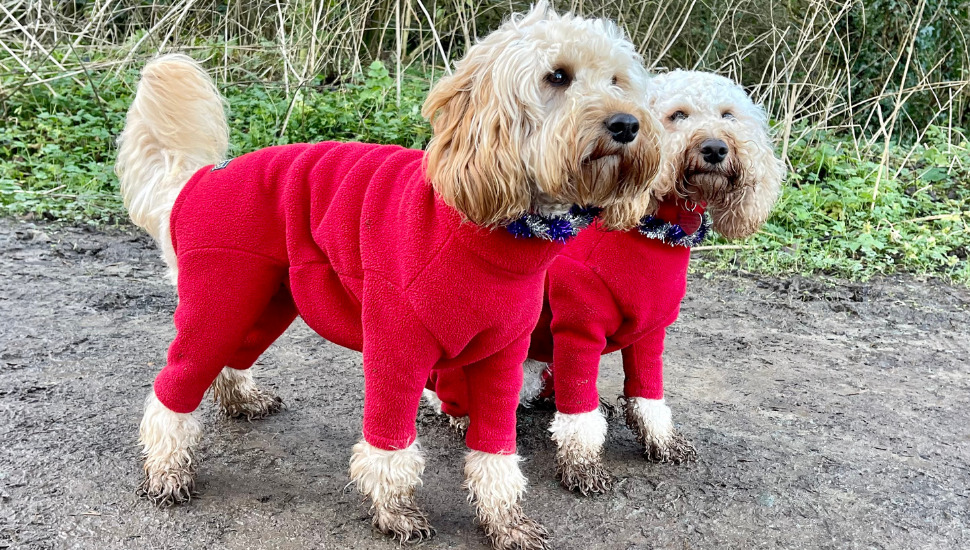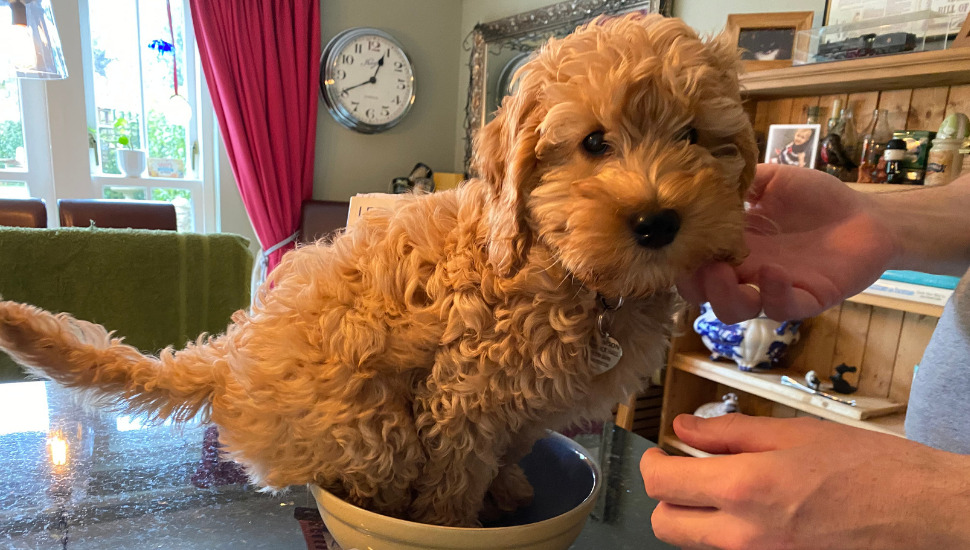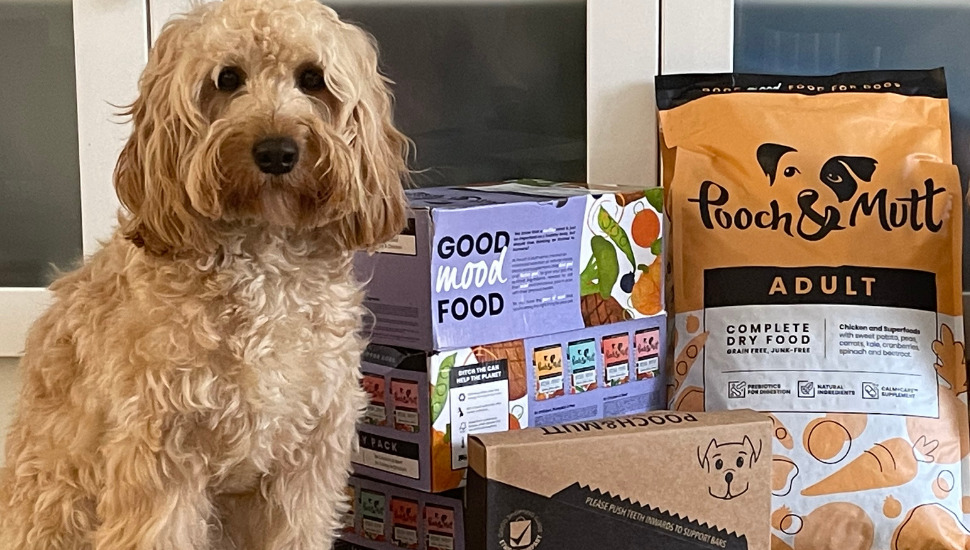Putting weight on a skinny dog was not something I’d ever had to think about with Freya. With hindsight, I now realise how chilled she was as a young pup. Even though she behaved ecstatically when greeting people and crazily doodle dashed with other dogs, while at home she was sedate and calm.
Frankie, however, was the complete opposite. By the time she was seven months old, I became concerned that her constant fidgeting and restlessness was having an adverse effect on her growth weight gain. Unfortunately, this occurred during a lockdown period. Our vet advised they were unable to see pets other than in an emergency and so I turned to fellow dog owners, along with the Internet, for help. As such, this means that although the following tips worked for me, they are those of a novice. I should also stress that after speaking to the vet, both he and I had no concerns that there were any underlying medical issues around Frankie’s skinny dog condition.
ADHD in Dogs
From being a puppy Frankie rarely slept during the day. At one point I was convinced she had ADHD, if there was such a thing in dogs. Having now researched the condition, it appears that dogs can suffer from symptoms of ADHD, but other than separation anxiety, Frankie displayed no other identifiers. [See Footnote]
Oh come on I hear you cry, Frankie’s a cockapoo what do you expect? But this was different to the behaviour I’d experienced with Freya and the myriad of doodles we’d met through our walking group. Frankie constantly twitched and fidgeted, was on hyper alert most of the time to ensure she didn’t miss out on a thing. Had I not seen for myself what a wonderful start she’d had in life, I would’ve had concerns as to whether she’d spent a lot of time alone as a puppy. This was definitely not the case; she’d been loved and well cared for by her home breeder before she joined us so that didn’t explain it.

Identifying you have a Skinny Dog
With a mixed breed such as a cockapoo it’s difficult to know what their end weight is going to be, it’s just guess work. However, one of the physical effects of being constantly on the move, was that Frankie’s increased metabolic rate must have been eating away the calories. The result was that as she grew we really struggled to maintain, let alone increase, the weight she’d gained during her early months. Also, with a long haired dog it’s easy to miss weight loss unless you check regularly. I also thought it could be a normal part of the growth process. However, by eight months Frankie’s spine was like a string of exposed pearls, and you could play a tune on her ribs (metaphorically speaking naturally).
Food Intake
Yet by this time we’d increased Frankie’s daily quantity of high quality protein kibble to 150g – enough to feed an adult cocker spaniel – along with additional healthy treats. Even so, she was ravenous all the time and we were having to use a spacer feeder to slow her down. Frankie pounced frantically on her food as if she’d been starved, whereas Freya scoffed hers quickly in order to claim the treat that always followed (a relic from the days when she was a fussy cockapoo).
Exercising a Skinny Dog
In terms of exercise, up until Frankie was 11 months old her off-lead walks followed the prescribed time guidelines recommended for her age. She also had free fun run times with Freya, chasing a football for 10 minutes. Once at home, I encouraged her to sit still and rest to preserve calories.
And then it clicked. When Freya was a puppy I was still working full-time at a desk. Now I rarely sit still during the morning as there’s always something that needs doing. Computer work now happens after walks in the late afternoon/evening. And so it seemed Frankie was just mirroring my behaviour… when I stood up, she jumped up and followed me around until I sat again. This certainly wasn’t helping the skinny dog issue that was for sure.
So back to how I put healthy weight on Frankie while ensuring Freya didn’t feel left out.
Tips from a Novice
Tip One: Seek Expert Advice
This was my first port of call just to ask the vet to give Frankie an overall physical. As a lockdown puppy, she’d only just been squeezed in to have her initial vaccinations before the first lockdown. Sadly, I noticed Frankie’s skinny dog condition during the second lockdown and they were no longer doing general appointments. I would have preferred to gain the reassurance that nothing was medically wrong, but after a few questions, they didn’t seem concerned and said it was probably a growth spurt. While the Internet in general is not an ideal go to, the information I gleaned from this and other dog owners did the trick for Frankie.

Tip Two: Analyse the Food
Initially, I analysed Frankie’s food, along with the amount I was feeding her. I’d followed the pack guidelines with Freya and she’d thrived very happily on the same high quality kibble for three years. However, this wasn’t the case for Frankie. At 12 weeks she weighed in at 4.2k and steadily gained a kilo every month until August when her weight gain almost stopped at a time when her limbs were growing fast.

I now understand the guidelines on the packs are just that – a guide. Every dog is different and I needed to increase the quantity for Frankie. Kibble meals lasted seconds and left them both hungry until they drank the water required to swell the food in their stomachs. I decided to add wet food to the kibble rather than more kibble, for instant gratification. I chose British brand, Pooch & Mutt, as they offered wet food in recyclable cartons. By offering Frankie a carefully balanced combo of kibble and wet food, it took longer to eat and left her far more content after each meal. It also meant that while I was giving Frankie an additional amount, I could get away with just lacing Freya’s food a small amount of wet food.

Tip Three: Establish Meal Times
How many times a day you offer meals can make a difference to help increase weight on a skinny dog. The Kennel Club recommends four meals a day until puppies are four months old, three until six months and then twice a day for the rest of their lives. However, if you need to increase the quantity while they’re still young, apparently the key is not to overload their stomach. Frankie’s weight remained fairly static from seven to nine months, which is when her spine and ribs became noticeably prominent. And so with the additional food increase at nine months, we reintroduced a third meal time. This was reduced to two by the time she was 12 months old.
Tip Four: Aid Digestion of Food
However, adequate time should be left between meals in order for the food to be digested, otherwise the intestine doesn’t have time to access all the nutrients before the body evacuates it as waste. Online medical experts advised that the time required to digest a meal depended on the size of your dog, along with the amount of liquid in their food; for a miniature cockapoo it’s around five to six hours. I also ensured that Frankie had the largest meal in the evening, which is when she has learnt to remain calm and rest. This ensures that she gains the maximum benefits from all the nutrients. I take care not exercise the dogs for at least an hour before or after eating because of the risk of bloat.
Tip Five: Additional Treats
Rather than offering high calorie treats such as pigs’ ears which are drenched in saturated fat, there are healthier alternatives you can give to increase weight if this is necessary. I utilised all of the following variants over time which again I collated through online research.
Sweet Potato: I discovered that this clever vegetable no only adds calories, it helps stabilise bowel movements.

Peanut Butter: Frankie is occasionally given small amounts of Whole Earth smooth peanut butter (pure version with nothing added) on a carrot as treat. Adding it to a carrot was a great discovery as the carrot has low acidity and helps avoid stomach upsets from the richness of the peanut butter. I give Freya just the carrot so she doesn’t feel left out.
High protein snacks: Everyday foods such as eggs (hard boiled or scrambled), cooked white fish, and raw lamb bones, also added valuable calorific nutrients to Frankie’s diet.
Tip Six: Gradually does it
The most important aspect of changing any dog’s diet is to increase the quantities of food, alongside introducing new foods, very gradually. It’s crucial not to panic and stuff your dog with various goodies in the hope they will gain weight quickly; this could cause real digestive issues, especially in young dogs.
Tip Seven: Exercise
I introduced calming methods into Frankie’s day so as to reduce her constant fidgeting and prowling. However, research showed that giving dogs adequate exercise is important for weight gain as it helps increase muscle mass – common sense, but not when you worry that it burns valuable calories! Now Frankie is older, I am able to give both dogs a good walk each day, incorporating play – they love chasing a football together – and zooming with their doodle friends while on walks.
And its working!
Frankie was one on the 5th January and I’m delighted to say that incorporating the above tips gradually over a three-month period means we can now feel her spine and ribs, rather than see them (my indicator rather than actual weight). She eats with gusto instead of desperation and although Frankie still has trouble relaxing unless encouraged to do so, she is definitely improving.
Footnote
Abridged version of the Results and Conclusion
from a study of ADHD like behaviour in dogs
Results: Various social factors, such as affectionate behaviour, number of social contacts, duration of period of separation, physical parameters (amount of play time as puppies, frequency and duration of walking and possibly castration) were associated with ADHD-like behaviour across all the dog breeds.
Conclusion: Although ADHD-like behaviour does not appear to be a heritable trait, the results reported in this study combined with existing genetic information about this trait, indicated that the expression of ADHD-like behaviour in dogs would appear to depend on a classical gene-environment interaction as is the case with many neurological disorders in humans. The conclusion is directed towards making recommendations to improve the social and physical situation that might minimise the potential for the development of ADHD-like symptoms in animals that are genetically predisposed to this condition.
Absolute fund of information & as always a super read. So happy to hear that Frankie is now back to a comfortable weight. Big hugs to you all xx
Thanks Nicky, so glad you enjoyed it. Hope coffee and cake was to hand at the time.
We have a 9 month old cockapoo who is constantly active chasing the neighbours cats which I don’t mind as they decide to do there business in my garden. We got Dotty by chance after a elderly friend couldn’t keep her any more so we took her on to which she’s settled in now. We put a bowl of wet dog food on a morning but she’s a very fussy eater she likes to go back to her food all morning but by dinnertime it’s all gone so we feed her again at 4pm and again she will pick at it but she’ll have it finished by around 6pm but she’s really active that’s what I’ve put down to a lack of weight gain cause she never stops but sleeps all night long not a problem, we’ve spoken to a vet that gave her a all clear and is very healthy the vet says she’ll will put weight on but it’s very worrying because like you we can play her ribs but she’s a very happy dog and loves to play with other dogs just not friendly when it comes to cats..
I just wish she would hurry up and put some more weight on so I reckon it’s a waiting game…
Hi John it sounds like you have a super happy puppy and nothing to worry about in terms of Dotty’s health. If you read the
Feeding a Fussy Cockapoo blog I wrote back when Freya was a puppy, I’m sure this will help. I learnt about the 20 minute rule when putting down a dog’s good. Totally different to feeding a cat! And Frankie is just the same as Dotty, loves chasing cats, but doesn’t understand when they won’t play with her 😀
I have always had a golden rule, horses graze, so if or dogs don’t eat breakfast we lift it wrap it, give them this for dinner 4pm. If dogs know there’s food constantly they know there’s no rush to eat they can graze.
Absolutely agree! No dog will starve itself.